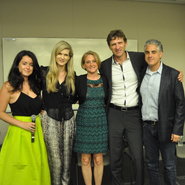By Dan Hodges
NEW YORK - On June 18, the Location Based Marketing Association held its spring event, “Innovating Luxury, Improving the Shopping Experience,” at the world headquarters of The Associated Press. Elizabeth Paton, U.S. fashion and luxury correspondent for the Financial Times, moderated a panel discussion with a panel of industry experts.
Here are some of the highlights:
Luxury marketplace is huge and changing rapidly
Sarah Willersdorf, principal at the Boston Consulting Group, said the $390 billion luxury industry has been slower than other segments to adopt ecommerce and omnichannel retail.
“Omnichannel is the blurring of lines between offline and online shopping,” Ms. Willersdorf said. “Consumers want what they want when they want it. We talk to clients about e-influence on shopping.”
BCG recently completed a panel of 10,000 consumers to understand their purchase journey. If you include purchasing online, researching offline and researching in-store and purchasing online, it influences 53 percent of all luxury shopping.
The United States is an emerging market when it comes to luxury. The country has 23 percent of the world’s GDP and 44 percent of ultra-high-net-worth individuals and 30 percent of the world millionaires. Yet the U.S. represents only 20 percent of luxury good sales.
Back-end infrastructure most interesting to brands
 Dan Hodges
Dan Hodges
Several points were made on this topic.
First, CRM and developing true relationships with customers and understanding who your customers are is critical. Are they tourism customers? Are they local? What are their preferences?
Next, analytics that bring point of sales data to interaction data is also critical.
Finally, there is the entire back-end that brings together omnichannel integrations.
Brands need the ability to look from any store to locate inventory. They should have data on all of their customer interactions, no matter where they shop. Do they shop in China or do they shop in the U.S.? The luxury industry needs a single view of each customer.
Front-end creative and backend technology should marry up
Debbie Kiederer, principal at ChalkDust Consulting and cofounder of LiveLux, raised a key issue.
“The front-end creative and back-end technology have to marry up,” Ms. Kiederer said. “It is a challenge to get the aesthetic to portray your brands.
“It’s not only about how it works, it has to look right and feel right,” she said. “We were faced with this challenge in developing LiveLux.”
LiveLux is a clienteling tool that allows the sales associates to maintain a close and personal relationship with their consumers.
Systems need to work together to ensure a superior customer experience
Frank Zimmermann, CEO of Arvato Systems North America, said the luxury industry is about captivating storytelling about the brand’s product.
“It has a lot to do with trust, loyalty and superior customer service,” Mr. Zimmermann said. “It is critical to have full visibility in real time of your inventory.
“Omnichannel means order online and pick up in-store or order in-store and ship to home,” he said. “All the systems need to work to ensure a superior customer service. You need to have all of your product data in one place.”
Beacons merge physical and digital worlds
Aaron Mittman, CEO of Sonic Notify, opined that beacons merge the best of the physical world with the digital world bi-directionally.
“It lets you know within two feet of an aisle,” Mr. Mittman said. “You are able to track consumer movements and product movement and able to send consumers relevant communication.”
Mr. Mittman said that 2014 is the year of proof of concepts. Sonic Notify takes a crawl-walk-run strategy with its clients and claims it is getting a strong response from the retail marketplace.
Dan Hodges is managing director of Consumers in Motion, a New York-based strategic consultancy offering business, marketing, and technology services. Reach him at [email protected].
{"ct":"un79aisMWmlI+6HEiNvYMi7ARf4DvnDjxfeP5UPy8CKwcJvpuLacfoyfWt1k3zII0lrlv3fiUzc4M3BglBwZxlD9ObKhYwZWYgpt0Q2GbqM4KTfJjJChIAP9yJzVzyQI+69Q\/dVbUjjigEpl7245jQuoE\/Dj\/efWr5\/dHDDauvRYD98gzTOlPJOnQW7UqDNcYdwOShPK52HMew71ZT0L2TfclA2EB+qta2fZ9wAcfxbZ\/aNpm7QTAXTzJ8OUitPUkC\/AHVhzR0df9R3x4OOyPKFi28pX73yw2X60nAbo2ifinQkHIZBrsMl1994aX3a5iFLXDBOYmTM7jjOdOLpa9vt5w8yNlH+yUm9Ju671IZBhLDgSE4vHhXGDd5h3T6NqpJ6+Je2r9zNuVlTJgk6CcUMOztlGihDwI1MktFGFViaRRUft8RwEU6s\/LlB\/a4L1kwdmGg2snoQYdny6ET0eIcwx+lJ+8ImJJvt7qKojpdkpzRP4desJelEgPOa4JvFa64\/4H6Jw+umGK0bA9ZweN7swAOMCfOarQpFBRaN4rS8y4gdv\/UCWPVIEdSEFC5\/C43UQ\/K3MWPnfoZZ6XxNB\/f3SX8m72M2eh2vH++PUKddrMHXSRttmlc2auGz5obtlvq5Y1gyTGfuhEOLZgFxuBo5za1LJi1AfHIXajGR4P\/WUh6YIDxxMU7gSvYXsdVxOoV7Ys7lOs3qdU\/5tkTaubJlFkxGtZDZ+78vvHT8zLCfoJyJvkgw8wCXR37tlyUr75hPw0HzIZ9M6xBPJl89GtezfT0QHMKsOtnjJy5C6cCzdE4b9gEv8EQ7F1FfGlA4bNf4xlwDReGQSjvzAK7UHXntPcKaaXUIVBRFeRM+wXzS3SfoxFPRszmkwbGosnFfQ+C2CnAfUNypodHPgPpMhOLvEyP3gQwMk9pzFWT6s7AXr9Z8oc438IuwJe9Lg8sLXWH\/yc1XO\/vfb\/Fr4ZOUFEoUspbH4ARmZ\/0pPG1otjtbvLwNrtbmZb6wjaPMxQS8eRIA6uNw57aD4VJOLGhbGFYTQDMMpjXNA2c1A1NR9nggRATM0FC9Qbm28np+n2FuXQSvEVwQ7aBrEYcQw9iEfcR7Stb5uFx0DNM9D8HrM44Ntj3nRS8+OxIeySTvQBGWGYKp61yGDtvjhA7PXPsC6QfgJL1wUv4gGu09zGmN9sTWPkpnTCr6oICcoFZ5q5+xKa3lpBQTeZXX9ScUPJirnKnFk0JYcn8VPhXtUfzzGxtl5CB1tjEqHA7uaRbPFR\/vWFCDSWgZdrp1tJpuVygUjbYuuljMutRyvslvyCvhK24VcSK+6LVzDKvgH4ne7iEPuxek0HL03U2OMq6sqMz3NcUF\/Rm15yTXLWLAhl3UvTP4jDpK\/dYub0uxSAdUlGOcaRoetiBmZpzlv5l4FMkJjTvz2Z0hja9Bsc2RNks6TXp3h+qsg\/Qv2NyNOEWSADc\/HdQnaHQpr3Ptlk1bwI7gs55cyKSSTwIeyqSlnU1gS\/e\/e5BDYxxsxnlfPH2lqRzM+5x6R6A2mahUfoUNxw\/GfMBu69Oq\/yNzUCIft9WG4qbHoPM6Wtqktx\/oqezeKG564HqqqHNxbQ36ppuK173qzTwMcQdJpV2FNtgIKEHJnAlLvc5TJOl+U6kytQvNhMXx3hr340dIanFBzXP8E+qjPyj7dkVtX1EwetEV+DuMA0kVcnzS88qKx2rR3hGNsEHPmQWc\/2aTVZ0Of4MjBUxzdTawtYjlHBg8PsqKDC6jU8b4fwx8L85pfxxY2SXbRVfVD8R\/zRfIyoo26rxzm+KTSkuIXCLssQLCKPPlz1YKpBn0UIsYrln4UNNib+rIr8ytCoHTDzv9vk9PySV4kKyiw20u+RFQCQmd6aC5+7wrWjADZhBmSHCYUMd9GBFU+CZNodD0unjunSmMsWyEbI1btqvC8VcOOw9za6rf\/82kaZy8GuMkSkk1iWcha\/\/HZCJyCW5jmZedyCCpIopzQgAjzBuwK9yiJx\/GKpRsm2MTMp9c5I6JrrgeZbsGw7Iix9M24IJiW++8cFMfxpxKHMeiYb7hSqgUkSWckGDmzHAkmYmxL3YtDSCnHFl02pM5FdZJ0+DDxA2X3Vdf2tFvNzY+LrRWnXo3KnlLf1nif8PqnXLFAIRR\/LA+YuJ2hxoZ5K1r7bGqQUitwlNgQ+QxoriUoQ76PxF6YlmdSPmEMnsCU6H5X1fSBJLT0PMfphSwtjyXRIZzXQ52T7jODr2w3qqGb8AgoomTcKNxtPKF2em8EEmSz5AsjvP0kPIBFEMwexJORjgOpft0B0t6yZ0Q2Tulv9jz7NnVJioSG6pgE6RIWlWiPe3uKzw9RrA74X9zL8lKqHNCuJp8+ZKBf5lHEjClIDPslRMAQRAJ+T64KDsgzd1H84u13zX2+KfaXancKpobrVNsCCKSi17s4VSzpw3vYOXxL\/w+RJegWO4waa+943fDRzdZr6WIJ0jCMSomM+NcyRmRUmFmrtbHzfsA0DFOgTiCd5R2uVBGMVnXreks5TmBbwHtcmmwT9tC7H1c0Xqvay6smWwriD4v7RlO0\/ZeS8Pa2OmeYFDpEux6HLs+ou4PQd5lS6fUY0ZMRCCMRGpg\/eKBtzSgO8GZwKwBA2NRTGDpDkHzHN3RkVOCdywqKIVs4lzVzt8DfKMhvry24k2rwZQplHt7P+gRPhRjKmxVVsTEMbh8qsY\/Atdw68vbQPxDFB\/MykEettkB3CRzgANf7GTb284o22FILw57V4jUvPfujGvoBBSxAciYr+\/MtV74lTvbYGnFJp9ma99c+2CxeDbUgsZ35iTdAIuuQj4UIOVR8THvlWY2Q+LGs9+fI8uD1x9NjDQeapjgib3cGpQ4NSUJoAdv6T\/t7E5Ownz11NTN13kaI2Y349FKo7ecLRmhrWDBzESTawqBbARM0FwiJ8xuxQ\/m7QNxqVm0s2VmZvTgJscENxsikGUq0WGz36nUaOesc1rW4\/KHkkJwQVKWNfh2QezqNUEcQVisjDSK1\/BGNTQW2rHVRN7oCZ1pEqrft3qjxhSSqBkB\/1GD\/rGr4DLoKprw4ZNUXS2DmQ+a9k5MQq4jPXXR9hkZiKdmwsAWTyk7TwfnuB8LKGRhLQLMJhk7lSm1m9cln8l4tkOBP3ltM4Wrpo2O19HNu8Fq29pQwEhQSDvHOrFlBLK3iQqSJEXulOHaYj54FmmlnOYpzIPNnyz0sHGKu8B3n3h2j5zKyJxgzRZh8rd9s6Zb7vCpIo0m5SjSDFACfUHPP8NwJ3C51oa7cYzx7MUeLmq3qWpisTmoF6SYJLD79fcy3Hgx+ITi29emFlUhtjLUpE+vzn748\/OH42v7JZNA0vEzbN9vuuE4QXtnTsFqXAHdko4BK2Ij9wHzeD8TkpHKmAu8Kr\/NuxTThSkSGyQAg4r9ytuwtopM0Ds9+JZyWIZxVVeAxWuRt1\/vyQKsUCTHck3irjwGxn6fITOEI9eSwRZ\/ZLgJ4wgZjFXaQNRgOPjc7x\/aEtCzUAZFi7VI5Q7wMSlAQiqWoNoLsmC8qqflPvCCmyOKCXihGkw\/SSNo\/9xRtbcE02USQD4ZGHTROKGWixWq6vtK0BfUwUZI1SPp5i1r2tUDiZ1tL78Ggn+m32ko2C\/xAxLwsUmVJ5uAw2FPl+KMS62EjFtmMeDliHNh65IZGkW8WE1zk+5KNUEEFjrChyn\/zbWN78pV5EaWhaPNWz\/uZNs10TcyvTJPfS\/W56GJ6h9t5kEpQYqWyMNN8fxKSkfQBm9s8+W\/wHKx4u9EwIA+lLAHfgPs\/c2QJCzvHjRdS4erOaFihKb1s+82Lvv9CFhviEYH6snuLoBxGmq+XPgNhlZIXWaBg2haRFiAJS66uyFmMm3rLf3BMU0JVSvSQglcO\/j3Eosnt3Fja+pBFTeiIzqw+ELNyBTwrnGmUCSLn2aLm+x6dGfkOxFjGDYnDqKwqlyXQy2Hwi51irnqGnBucUEon7YBXTr2o9EMYmqn\/47TumPd2FW5xamP9R5Y2rPXdha3lbYlyv2QhG+MGK6xZl8unDQ9erY3PTH8A1VDpZ7jEMrJs6NlaO86\/S\/fW+TQ17u3E49t+qehisa3Li8jqamZwNOtylpJGj8jWdS7BmtNI5fvV77ocAs7OwFIUFUFk0jW7aSRqjtQ0Sy1drI4pCDqmMVU4YQ4gAq\/ZYkLNvF0ZP5QqjsKl3PoXZEozAh7YG3m1QaD\/jgXs1ot+Em3Os8iG9ddIrK4pJ6M0E5XwVU6F7x9fozlI6CIvL\/9FpiEOYQHfWHwUz4+YJrR8m9O9zbAQ7kLKeimtEFK3K6O0AEem+v6mywPOS9iPWRrie3HLptqeHvvkwkIag2gpkOpO9JJ7PkJB86kxtv\/ncutAN3z\/tQTTqqejhS10vU8l9noWwWHQBDvy3PhhrSnpqus5mkFogQY+TudJ96lPqlY6IVlN1uS+SftCmIUfdnFf7PrXPPe1QO236oFSvVVpUM+T9a\/fosqmYkbw6Xf1dPkG5Gahy7LZIRN0baG5JqIZGLOeSN1gPOVdnNqZidoOn4FA40YPSrOyRFhg98fjU6\/uolhx1tN00ewkL6WtCXtlV5sdvzuXL6k5\/e1VyENPwbmG7sxbhRxjDuDBmfOpSPDfXb5dFyj6usP0e5zW1HtdVYrP++42Vu8qQe2v4faDRl37AqGb6aWP1jjCS7rHt9JVTGfLcH+P9kEtvl3GbBzHDjWxZoJ1YUCc9bevlQCtb5UurIE2a1ZR5ECp5A0XRBHbjDVAxzNEc8HK0dVMgZOdcWG9h2eyZOMKn5Mzy+zpiG5EWxcKMV6AqXQgZTZiCLkg7wjFIzcki\/VsHQrnmbTpcv9\/zTxI26ZMkxDorDKpsw6f8qg6m\/qwlNqUNrDxvturVsfaLPqkJ6rG1YsOuMBuX6lmbROxFnUbKiDHsuHioFKmvFR9UIW\/7gEBMzOa8FNavfkDRQ0T1uZ37KieujM4R6ISSv1W6oZfN\/wsek5QOhr4762FYtaFUskssdJsNimUn31z+m4L2mtHUiTqMT6qAwgP0Sya5y7ab7rNXMeoK9z7kSBuDE8+ZE4SCcIzigD7\/yAvOWLyRza39Ush4oRyVV2HTOd6fLpF0+g8vzXiTEpMrQ4vqQS9RPT6u4P0k2WcyDAaW\/l7YMMYGI3KFXNEpV5VVuBrIeqGp9PMDAmc2CfXbT92XD9cTLBL\/e\/CBsvAp5aQ8pR8ZfC6rBDaqUkhR9qn8dEMiSPJdYtuZlSZ+kguBlmNy9djVb62Mt\/E5JEOidEWAUCzJjQ01rEqDt2JHTfGfUYlnWnh\/sYP\/aBbIu77BkBJ47FLbxj82U4V4wLrEs3kf8x8P6C2DQNM4cP9QVByZ2n3e9hwFUWJPm6\/k\/5YJYNN7jZXJZEUuxMtt4V1DTSuZT\/0TRz2RmSS7Hb\/QtEUCupVYTeTi1y0WawojxAcF3mrel8oeOKUZcSfw7hvo6Z3BaFt9dJA649NldPdmPlMTKg2z5hVTxreez+fkW8hEefEkCsHJluWRp+rVAESceJmuKHkMVB4r7U3OffKW4XNyFamAP31cW\/77agtv4I\/0M3gVF1Mh+5Cc7MFfL4BuXmbY1s+CgTxxYVbuJjzUoBlQq\/x\/tAIhUfjxsGm8933in4xRehbZdl7a7Q9diGIz8fSpdFirKlGCSilMQzgSiMG9GfSIpPmBIMfXR+oaqXC7xXO7H+8vBgomU1otULPMCGLqm8DDyhfQlU23eaC3k3sX+\/fh0aiCSw6Ws1jtj71ocves2KET2zVkjWDidx2HQT7juZkXJOOJ\/rs2gS6m1sCCJaizWkHcMjiLq0Tzw2ELVr6L14JAS24+Ae\/45pR8XrfjKsqwWXHI6dQo+hKGo92\/w9AvXRD9TZfrPwm7933tiAWtD8V6RPBKkkiAIdptBHxAz9YR9L+XSexVKG1N5k8yHSLzrhKRMmCsqamAZ8yUWjfSdMNZvXtFOjKwaNtqGpD6nikdYYhMWdVs9RXf2iq+\/\/y6shDvX3MLxbeziEVaq3lP+FKOKzDB63gYXQrF5apfhHyYIwoJsNyeHkVbm8yd4BXNLSXKbxgPkjaCOy\/CsYu4i5l8C+JiRxhf6R4qBv7jNXgDqUu7nfaLuwMv4WJPhKJPCcGdDADM68C4DM43p7htH\/WpTsl15xc46MhJysvUtyqVTns4QtLiTC8k3yzw6y8Wj09fsDBn31nEKFqYajG0MwWTwx+QXGYSv8SQNdaYNWEiWIeOCtD21YqBZfD7Eo6GjeNJtbCpzOc0z73eGmXVNzjzENj4zrA8GEPQhW4x0svz6yhHpV5pxlEc+hvlTpDa8cx13eR3rf5\/ix6aMN353vA9LOaphoQe\/vTT5HS7iQ3xAAUh7M3j4son0HXyiVEcPDwpgbgXIVotjljkfhNeOWAeJJsj2vFOGbZJ9mFV\/s27NSAxYkvy1kPEfncxPalt2pv4acj8xselN7H8Jy54zIHPPzGF32NhWIoi2\/ibfC9vuoWn7pRlHNy8hvRrk8fwInrFbwB2XZoKrCj\/TcSgtG9QWDrsYQJELn+upanyrhkt7\/R5bpuKc1l4gS2\/pjxGzER3wgyNKHpotoBVm3Pt3ADWqGi\/P4gO\/KikpAu9jAwFpSqqY9Ogd\/M\/BzPyAQnOGdsvu9GNBK46frvuzL1hpSRkWwe0cVwpFeBo88JvMJ3KTg9R++i0vDa7lolULHVef3pOom9F0+USikbPyFafLhbE0sE\/FHS1NvpeF5ELAKWzf4otmunS3Th5ZPvAD\/vLaaWDxex\/DVI8yhV9b4sa0vw8zg5OI+dDGKZLWAz9B76vZmqtHJpRk8SWOGah9cyoVJ3hCB2fLkoU8wKoJMl1M629d\/CtTo4Zt4ZOzXywk3mQ2k5pHaf75yO1vJNlIISZf8a3lvrAj9TWWwlBu57GV+2K7RdG8NtMxa06Dx088yjHwdH5PC7fz9i+h3Dr3RWFAFla9HFBWyGLuhqM6IZk9tOkvh71EENnsx5sUE=","iv":"9651fa743d74951e0b9b6acef66fc94f","s":"e65b750364e501cc"}

 From left to right: Elizabeth Paton, U.S. fashion and luxury correspondent for the Financial Times; Sarah Willersdorf, principal at the Boston Consulting Group: Debbie Kiederer, principal at ChalkDust Consulting: Frank Zimmermann, CEO of Arvato Systems North America: and Aaron Mittman, CEO of Sonic Notify. All spoke on a luxury shopping panel last month hosted by the Location Based Marketing Association at The Associated Press HQ
From left to right: Elizabeth Paton, U.S. fashion and luxury correspondent for the Financial Times; Sarah Willersdorf, principal at the Boston Consulting Group: Debbie Kiederer, principal at ChalkDust Consulting: Frank Zimmermann, CEO of Arvato Systems North America: and Aaron Mittman, CEO of Sonic Notify. All spoke on a luxury shopping panel last month hosted by the Location Based Marketing Association at The Associated Press HQ